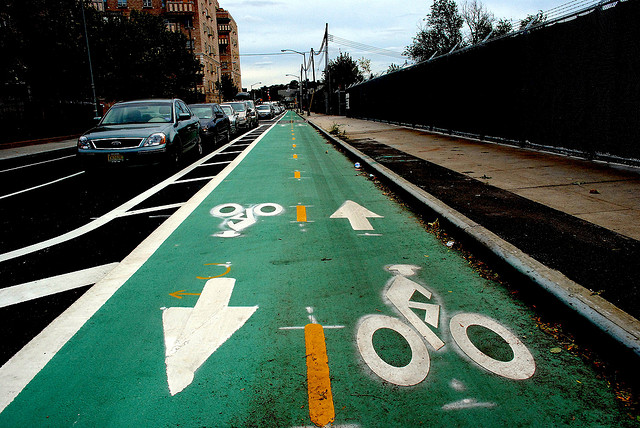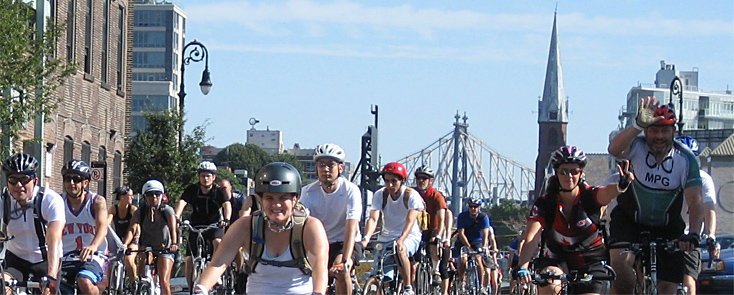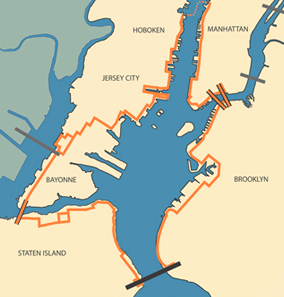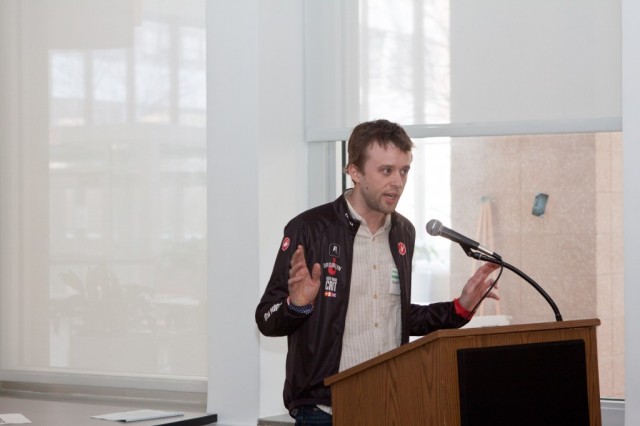On Friday, March 22, the Brooklyn Waterfront Research Center and University Transportation Research Center hosted “Bikes and the Brooklyn Waterfront: Past, Present, and Future.” The speakers delved into the history of biking, current undertakings to create bike lanes and redesign streets, and proposed future plans–all with a focus on the Brooklyn waterfront.
Hayes Lord, Director of the Department of Transportation’s Bicycle Program, touted the DOT’s progress in connecting Brooklyn to Manhattan and creating sub-networks within neighborhoods via bike lanes. He cited bike lanes installed on Kent Avenue, Prospect Park West, Plaza Street, and Prospect Park Drive as examples of safe places to cycle within Brooklyn. Lord also gave instances of bike lanes being used to improve car traffic, such as on Empire Boulevard where a new bike lane calmed a busy intersection.

Lord said the next expansion of cycling infrastructure will focus on increasing the amount of bike lanes in Queens. He discussed the risk of accident decreasing as more cyclists are out and about because automobile drivers are forced to be more aware. The DOT is now focusing on bike corrals as part of their bike to school initiative, and Lord’s overall message was one of using bike lanes to incorporate cycling into family life and get young people biking early on. When asked about the proposed Citi Bike Share program and if it could be terminated under a new mayor, he replied “Ending bike share would be political suicide” and discussed the political power of the sheer number of bikers in the city. An audience member asked about NYPD’s refusal to investigate cycling deaths, and Lord said that the DOT is working with NYPD on an “equitable enforcement campaign” to hold drivers accountable when cyclists are hit.
The Department of Transportation’s Bicycle and Pedestrian Project Director Ted Wright presented various improvements along the Brooklyn waterfront. In 2008 there was a grand total of zero miles of bike paths, and no dedicated right of way for cyclists. By the end of 2013 there will be thirteen miles of bike paths along the waterfront. Wright cited several examples of how bike lanes have been creatively constructed to adapt to various streetscapes. In Williamsburg a residential rezoning on Flushing Avenue led to a parking protected bike lane and a two way path that increased weekend biking by 300 percent since 2009. In Brooklyn Bridge Park a temporary bike path was created along Furman Street that can be shifted as construction continues. On Piers 7-12, there was a safety problem with the number of trucks and freight, so separate bike and pedestrian paths were created to increase the sight line. These adaptations show how bike lanes can be implemented in a variety of circumstances and traffic flows.
The next speaker was Steve Durrant, the principle of Alta Bike Share which manages bike sharing programs around the world. Alta will be operating Citi Bike Share in NYC, scheduled to start in May. Durrant discussed the benefits of bike share programs to help children bike to school and in emergency relief situations, such as Hurricane Sandy. He touted the economic benefits to stores that are located near bike share stations, as well as the increased tourism revenue. Similar to Hayes Lord, he had a strong focus on getting youth comfortable with cycling early on and continuing into adulthood.

Milton Puryear, the co-founder of the Brooklyn Greenway Initiative, discussed public space and the mental health benefits of green spaces as an escape from the built environment. Puryear mentioned the Naval Cemetery, Williamsburg Bridge Park, and Columbia Park as green spaces that are easily accessible by bike. He promoted the Brooklyn Greenway’s annual “Waterfront Epic Ride,” a 40 mile ride along the waterfront from Newtown Creek to Rockaway Beach which will be held on July 27th this year.
Ben Shepard, City Tech professor, community organizer, and author of The Beach Beneath the Streets: Contesting New York City’s Public Spaces presented on the radical aspects of cycling. Shepard discussed Times Up and their antiwar demonstrations, efforts to reclaim public spaces, and bike memorials and rides to bring awareness to cyclist safety. Bicycles are also extremely useful in disaster situations, as the bike powered generators and supply transporting cargo bikes showed during Hurricane Sandy. Shepard advocated “creating green infrastructure on a community level” as a pathway to a more resilient NYC.
“The Harbor Ring” is an idea advocated by Mike Lydon of Street Plan Collaborative which would link all five boroughs via a bike path along the water. The main missing piece is a path over the Verrazano Bridge. Lydon likened the economic and tourism possibilities to the Golden Gate Bridge, and described how local businesses would benefit from the increased traffic of a path.

The last speaker of the conference was David Trimble, the director of the Red Hook Criterium, an annual underground bike race where riders compete without brakes. The “Crit” was founded in 2008, and last year boasted 200 riders and over 5,000 spectators. It is held inside the Brooklyn Cruise Terminal and is the only public event held there. This June another Criterium race will be held in the Brooklyn Navy Terminal. Trimble spoke about the positive effects the race will have for the still recovering Red Hook community and their efforts to work with local businesses. For example, the race promoters designed a “Red Hook Passport” through which a cyclist can earn official race gear with a certain number of stamps from participating businesses. In the aftermath of Hurricane Sandy, a special edition race T-shirt was sold, and over $50,000 of the profits from it were donated to Restore Red Hook.

A screening of Racing Towards Red Hook, a short documentary about the 2011 Red Hook Criterium, closed out the conference.